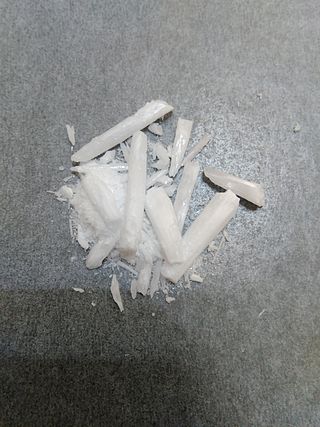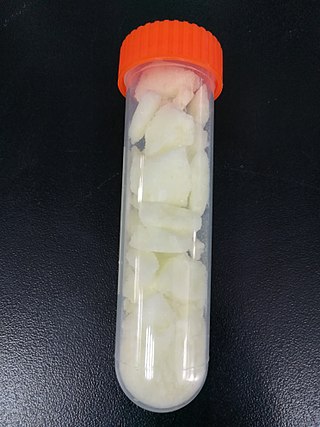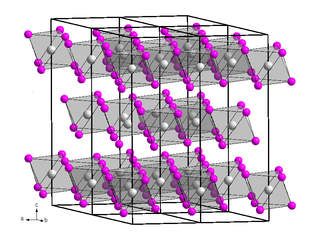
Dysprosium is a chemical element; it has symbol Dy and atomic number 66. It is a rare-earth element in the lanthanide series with a metallic silver luster. Dysprosium is never found in nature as a free element, though, like other lanthanides, it is found in various minerals, such as xenotime. Naturally occurring dysprosium is composed of seven isotopes, the most abundant of which is 164Dy.

Dysprosium(III) chloride (DyCl3), also known as dysprosium trichloride, is a compound of dysprosium and chlorine. It is a white to yellow solid which rapidly absorbs water on exposure to moist air to form a hexahydrate, DyCl3·6H2O. Simple rapid heating of the hydrate causes partial hydrolysis to an oxychloride, DyOCl.

Hydrogen selenide is an inorganic compound with the formula H2Se. This hydrogen chalcogenide is the simplest and most commonly encountered hydride of selenium. H2Se is a colorless, flammable gas under standard conditions. It is the most toxic selenium compound with an exposure limit of 0.05 ppm over an 8-hour period. Even at extremely low concentrations, this compound has a very irritating smell resembling that of decayed horseradish or 'leaking gas', but smells of rotten eggs at higher concentrations.

Selenium compounds are compounds containing the element selenium (Se). Among these compounds, selenium has various oxidation states, the most common ones being −2, +4, and +6. Selenium compounds exist in nature in the form of various minerals, such as clausthalite, guanajuatite, tiemannite, crookesite etc., and can also coexist with sulfide minerals such as pyrite and chalcopyrite. For many mammals, selenium compounds are essential. For example, selenomethionine and selenocysteine are selenium-containing amino acids present in the human body. Selenomethionine participates in the synthesis of selenoproteins. The reduction potential and pKa (5.47) of selenocysteine are lower than those of cysteine, making some proteins have antioxidant activity. Selenium compounds have important applications in semiconductors, glass and ceramic industries, medicine, metallurgy and other fields.

Dysprosium oxide (Dy2O3) is a sesquioxide compound of the rare earth metal dysprosium. It is a pastel yellowish-greenish, slightly hygroscopic powder having specialized uses in ceramics, glass, phosphors, lasers, as a Faraday rotator and dysprosium metal halide lamps.

Sodium selenide is an inorganic compound of sodium and selenium with the chemical formula Na2Se.

Dysprosium acetylacetonate is a chemical compound of dysprosium with formula Dy(C5H7O2)3(H2O)n.
Calcium selenide (CaSe) is a chemical compound consisting of the elements calcium and selenium in equal stoichiometric ratio.

Dysprosium(III) hydroxide is an inorganic compound with the chemical formula Dy(OH)3.

Dysprosium(III) nitrate is an inorganic compound, a salt of dysprosium and nitric acid with the chemical formula Dy(NO3)3. The compound forms yellowish crystals, dissolves in water, forms a crystalline hydrate.

Neodymium perrhenate is an inorganic compound with the chemical formula Nd(ReO4)3, which exists in anhydrous and tetrahydrate. It can be obtained by reacting excess neodymium oxide with 240 g/L perrhenic acid solution. In its solution, NdReO42+ and Nd(ReO4)2+ can be observed with stability constants of 16.5 and 23.6, respectively.

Dysprosium acetate is a hypothetical salt of dysprosium and acetate. Its proposed chemical formula is Dy(CH3COO)3.

Europium compounds are compounds formed by the lanthanide metal europium (Eu). In these compounds, europium generally exhibits the +3 oxidation state, such as EuCl3, Eu(NO3)3 and Eu(CH3COO)3. Compounds with europium in the +2 oxidation state are also known. The +2 ion of europium is the most stable divalent ion of lanthanide metals in aqueous solution. Many europium compounds fluoresce under ultraviolet light due to the excitation of electrons to higher energy levels. Lipophilic europium complexes often feature acetylacetonate-like ligands, e.g., Eufod.

Dysprosium(III) bromide is an inorganic compound of bromine and dysprosium, with the chemical formula of DyBr3.

Barium selenide is an inorganic compound, with the chemical formula of BaSe. It is a white solid although typically samples are colored owing to the effects of air oxidation.
Lutetium(III) selenide is an inorganic compound with the chemical formula Lu2Se3.
Thulium(III) selenide is an inorganic compound with the chemical formula Tm2Se3.
Erbium(III) selenide is an inorganic compound with a chemical formula of Er2Se3.
Holmium(III) selenide is an inorganic compound with the chemical formula Ho2Se3.

Dysprosium(III) phosphate is an inorganic compound with the chemical formula DyPO4.














